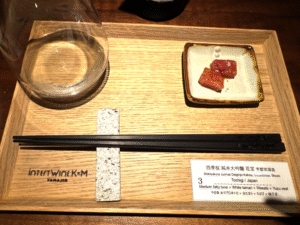
In addition to Japan’s longstanding tradition of producing sake, the country has a burgeoning wine industry. Although sake is becoming more widely available in the U.S., Japan wine (koshu) is difficult to find here. One of the joys of coming to Japan in general and Tokyo in particular is to learn about these beverages and how they pair with Japanese cuisine. And the best place to do that is intertWine KxM, run by Kenichi Ohashi, MW, the only Master of Wine residing in Japan, and his expert sommelier, Motohiro Okoshi.
Housed in the modern shopping complex of Azabudai Hills, the elegant intertWine KxM shop sits comfortably among Cartier, Hermes, and other upscale stores, and immediately above the Azabudai Market, a high-end food market with a sprawling food court.
Kenichi explains that most Japanese wine stores and restaurant wine lists focus almost exclusively on Bordeaux, Champagne and Burgundy, likely because the Japanese consumer wine market is still in its infancy compared to Europe or even the U.S. He believes a wide range of top wines pair nicely with Japanese food, so his store stocks wines from everywhere—Chile, Sicily, California—and at good prices, considering this is Tokyo. The selection is enormous—as wide ranging as you’ll find anywhere.
 But the real reason to visit IntertWine KxM is for the wine and food or sake and food pairings, what they refer to as their unique Component Pairing® experience, supervised by Okoshi and put together by in-house staff who have passed a company certification program known as the “Librarian” exam. This takes place at a stand-up counter in a stylish room off the back of the shop. They recommend reservations, which can be made by phone at +81-3-6277-8203 or by email at info@intertwine-km.jp. Doing so is highly advisable because the counter accommodates only six guests. However, walk-ins will be accommodated if space is available.
But the real reason to visit IntertWine KxM is for the wine and food or sake and food pairings, what they refer to as their unique Component Pairing® experience, supervised by Okoshi and put together by in-house staff who have passed a company certification program known as the “Librarian” exam. This takes place at a stand-up counter in a stylish room off the back of the shop. They recommend reservations, which can be made by phone at +81-3-6277-8203 or by email at info@intertwine-km.jp. Doing so is highly advisable because the counter accommodates only six guests. However, walk-ins will be accommodated if space is available.
The food and wine or sake pairing experience is flexible and tailored to individual preferences. When I was there, I opted for a couple of Japanese wines, since I’ve had no prior experience with them. Kenichi suggested a 2023 Grace Rosé from Yamanashi made from red Bordeaux varieties (he clearly did not know my skeptical feelings about rosé) paired with Salsa di Anna, a delectable mixture of tomatoes and red vegetables, and a 2023 Ajimu Albariño “Gokka” from Oita paired with a sour cream and yuzu miso. Much to my surprise, the rosé had character and verve, and was a perfect complement to the rather intense and balanced Salsa di Anna. Similarly, the racy and ripe Albariño (who knew that grape was planted in Japan?) beautifully complemented the citrus tang of the sour cream.
Kenichi insisted that I try food and sake tasting as well. Those pairings dramatically made the point that, just as with wine, foods as different as wasabi-touched fatty tuna and soy sauce and dashi-accented flavored cream cheese call for different sakes.
Alternatively, customers could enjoy a flight of wines or sakes, but I highly recommend the pairings, which are masterful.
What makes this experience so special is the Librarians’ ability to talk about the wine or sake, explain what’s in the food, and point out precisely why the matchups work.
The price of the Component Pairing® is modest—a bargain, in fact—ranging from ¥800 to ¥1,500, depending on the pairing ($5.75 to $10.75 at current exchange rates). One of the Librarians, Rie Matsuki, explained that, on average in March, a guest participating at the Component Pairing® Counter ordered about three pairings and spent around ¥3,500 ($25).
And if you need to buy wine as a gift for a colleague or friend during your stay in Japan, their shop is the place to find it.
May 10, 2025
